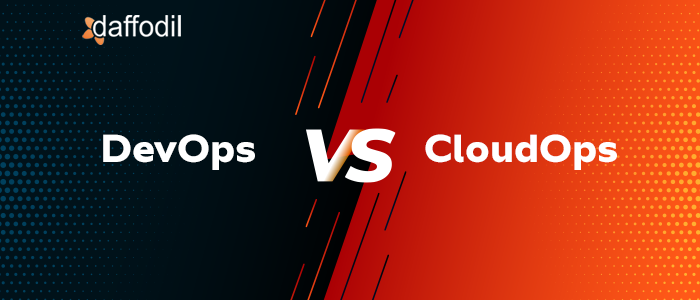
IT world is full of various terminologies that are often related to each other. When it comes to digital transformation, DevOps and CloudOps are often touted as two essential ingredients to get much needed competitive advantage and offer differentiated services.
For many, the relationship between DevOps and CloudOps can often be confusing, as DevOps is about processes while CloudOps relates to services. In this blog, we discuss the difference between the two with some challenges and best practices concerning CloudOps.
First, let's understand CloudOps and its importance in the cloud industry.
What is CloudOps?
Organizations today are migrating their IoT systems to cloud with the intent of enhancing scalability while optimizing performance and capacity. Regardless of which platform is used or what is the infrastructure location, CloudOps provide organizations with proper resource management. In an organization, CloudOps uses DevOps principles and IT operations applied to a cloud-based architecture to speed up the business processes.
CloudOps relies on continuous operations, and this approach has been taken from the DevOps. Now let's understand DevOps and why it is often termed as the powerhouse for business processes.
What is DevOps?
Developer Operations (DevOps) is a methodology that assimilates IT operations and development teams to accelerate the business processes linked with the software teams and the services they are providing on any cloud platform. The main objective of DevOps teams is to provide organizations with improved communication between development and IT teams. This is required to lessen the amount of time required to deploy any software or updates.
In a nutshell, the main idea behind DevOps implementation is to make the lives of the development team easier, and that's why it should always be human-focused.
Now we know the summarized picture of DevOps and CloudOps, so let's understand why they both are different from each other.
Difference between DevOps and CloudOps
When it comes to DevOps, automation is the key. It delivers agile and repeatable processes to get the best final product. In contrast, CloudOps is a way of doing DevOps - it's just that instead of using any on-site network server assets, it takes complete leverage of powerful cloud computing tools like AWS, GCP, and Azure.
Here are the fundamental differences between the two:
1. Affordability
With the enormous number of cloud-based platforms available, CloudOps providers compete on quality and price. The organizations that use cloud computing has to worry less about maintaining an expensive network architecture on-site. Instead, they can team up with the cloud service providers to get the support for all networking/server needs, without compromising on the affordability.
However, DevOps experts are costly to hire, and making any necessary changes to your software infrastructure comes with costs too.
2. Expansion Friendliness
With CloudOps, organizations can get unlimited expandable storage and processing power (theoretically) as per their needs. But in the case of DevOps, expanding or upgrading their infrastructure to optimize software delivery is not as easy, it is potentially expensive and a complicated procedure.
3. Development Focus
Apart from cloud development, DevOps engineers also work with online applications and downloadable software. Cloud engineers work to design cloud systems for internal use (for the organization), while DevOps engineers focus on streamlining the development and release of a company's software solutions (for the organization's clients).
How CloudOps Augment Capabilities of DevOps Teams?
DevOps and CloudOps are linked, and organizations that use the cloud can understand this fact very well. Before the cloud came into the picture, the organization needed to invest in servers. As such, the role of DevOps was limited to the development and operations of applications on those servers only. But with time, the demand for cloud-based consumption model increased, which completely transformed the DevOps role. It now focuses on automation, log management, application management, monitoring, and much more.
For the rapid delivery of reliable software, DevOps creates an agile process. Instead of completely eradicating the need for IT experts and software developers, it brings them closer. Philosophies and practices of DevOps can ease the organizations' decision-making process. Therefore, the role of DevOps in a cloud-driven environment is to automate all processes. As cloud functions are becoming more common, the IT teams need to look for a solution that can provide faster delivery of software without compromising on scalability and security.
Let's understand the benefits that cloud-based platforms offer for the DevOps.
Efficiency: Cloud-based platforms are incredibly efficient to use as they are not tied to a physical location; they can be accessed from anywhere. As developing on the cloud allows users to showcase their applications quickly, it allows faster time-to-market.
Scalability: Cloud-based platforms are best for businesses with fluctuating bandwidth demands. This scalability can provide organizations with an added advantage over their competitors. It also reduces the risks linked to maintenance and operations.
Disaster Recovery: IT organizations face the risk of losing all their data and not able to recover it. But when organizations opt for cloud-based platforms, they don't have to worry about it anymore; cloud assures that the data is always available, even if laptops or PCs are damaged. For all sorts of emergency scenarios, cloud services are always available with a quick data recovery solution.
Challenges in Adopting CloudOps Practices
Making a move towards CloudOps can be challenging. Therefore, it's better to plan out things and introduce best practices to simplify monitoring and management between cloud-based and physical systems.
Following are the challenges that often occur while adopting CloudOps practices:
CloudOps works using dashboards and tools that automate the monitoring process, but that doesn't eliminate the need for hardware; cloud-based platforms also require a physical server to operate. This might involve an extra layer of troubleshooting and maintenance from both the cloud help desk and the traditional help desk.
To ensure the smooth transition, the right expertise and guidance are required, and because many of these technologies are new, it's challenging to get the needed support from the limited pool of people the organizations have. Thus, to have a successful and robust CloudOps transformation, a consistent plan is required.
Organizations often face compliance issues while migrating to CloudOps. It is the duty of IT governance to ensure that IT assets are implemented and used according to the terms and policies and that they are being maintained and controlled.
CloudOps Best Practices
CloudOps includes the use of intangible management layers to manage instances inside of the cloud and the other essential systems, such as security. Let's take a look at CloudOps best practices:
Provisioning: CloudOps provides organizations with a different kind of provisioning, i.e., managing the provisions of machine insights on the cloud. There are two types of provisioning available. The first is self-provisioning, which allows the cloud users to have their own machines, and organizations can track the usage. The other one is auto-provisioning, as the name suggests, in this, applications themselves request more machines, and they can automatically de-provision the machines when no longer required.
Setting Limits: CloudOps best practices involves setting limits as to what all can be done within the public cloud environment. With a cloud-based environment, a user can provision their own machine, but it's almost impossible to set-up 1,000 machines at a time. This is the reason why setting limits is required to ensure that applications are being managed within budgets only.
Automation: It's essential to automate almost everything. This can include anything from user management to API governance. When automating the CloudOps processes, organizations can themselves understand that most of the processes follow a naturally repeatable pattern, which further helps in automating the processes.
Self-Healing: While automating the processes, it would be a great thing to introduce the self-healing capabilities of the cloud provider. This means automated procedures should have the capability to correct minor issues by themselves.
Final Words
CloudOps is a trendy buzzword, primarily because of the value it offers to the businesses. DevOps ensures continuous operations, heading the organizations to a simplified way of building and deploying software and their applications. In contrast, CloudOps is a way to migrate continues operations into the world of cloud computing.
From a technical perspective, CloudOps offers many advantages. CloudOps and DevOps together can improve the applications, infrastructure, processes, and most importantly, help the people maintaining the services.



